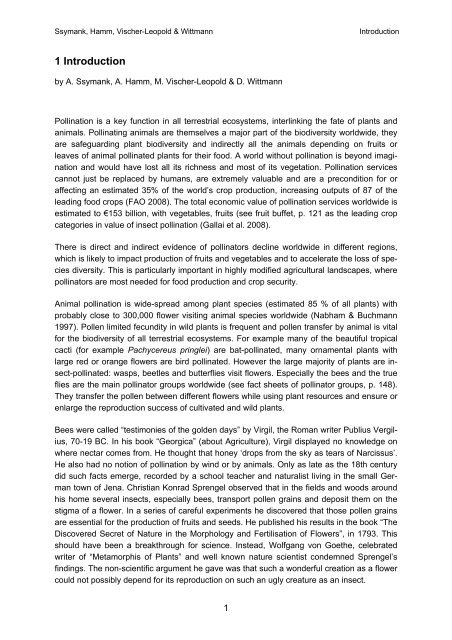Caring for Pollinators - Bundesamt für Naturschutz
Caring for Pollinators - Bundesamt für Naturschutz
Caring for Pollinators - Bundesamt für Naturschutz
You also want an ePaper? Increase the reach of your titles
YUMPU automatically turns print PDFs into web optimized ePapers that Google loves.
Ssymank, Hamm, Vischer-Leopold & Wittmann Introduction<br />
1 Introduction<br />
by A. Ssymank, A. Hamm, M. Vischer-Leopold & D. Wittmann<br />
Pollination is a key function in all terrestrial ecosystems, interlinking the fate of plants and<br />
animals. Pollinating animals are themselves a major part of the biodiversity worldwide, they<br />
are safeguarding plant biodiversity and indirectly all the animals depending on fruits or<br />
leaves of animal pollinated plants <strong>for</strong> their food. A world without pollination is beyond imagination<br />
and would have lost all its richness and most of its vegetation. Pollination services<br />
cannot just be replaced by humans, are extremely valuable and are a precondition <strong>for</strong> or<br />
affecting an estimated 35% of the world’s crop production, increasing outputs of 87 of the<br />
leading food crops (FAO 2008). The total economic value of pollination services worldwide is<br />
estimated to €153 billion, with vegetables, fruits (see fruit buffet, p. 121 as the leading crop<br />
categories in value of insect pollination (Gallai et al. 2008).<br />
There is direct and indirect evidence of pollinators decline worldwide in different regions,<br />
which is likely to impact production of fruits and vegetables and to accelerate the loss of species<br />
diversity. This is particularly important in highly modified agricultural landscapes, where<br />
pollinators are most needed <strong>for</strong> food production and crop security.<br />
Animal pollination is wide-spread among plant species (estimated 85 % of all plants) with<br />
probably close to 300,000 flower visiting animal species worldwide (Nabham & Buchmann<br />
1997). Pollen limited fecundity in wild plants is frequent and pollen transfer by animal is vital<br />
<strong>for</strong> the biodiversity of all terrestrial ecosystems. For example many of the beautiful tropical<br />
cacti (<strong>for</strong> example Pachycereus pringlei) are bat-pollinated, many ornamental plants with<br />
large red or orange flowers are bird pollinated. However the large majority of plants are insect-pollinated:<br />
wasps, beetles and butterflies visit flowers. Especially the bees and the true<br />
flies are the main pollinator groups worldwide (see fact sheets of pollinator groups, p. 148).<br />
They transfer the pollen between different flowers while using plant resources and ensure or<br />
enlarge the reproduction success of cultivated and wild plants.<br />
Bees were called “testimonies of the golden days” by Virgil, the Roman writer Publius Vergilius,<br />
70-19 BC. In his book “Georgica” (about Agriculture), Virgil displayed no knowledge on<br />
where nectar comes from. He thought that honey ‘drops from the sky as tears of Narcissus’.<br />
He also had no notion of pollination by wind or by animals. Only as late as the 18th century<br />
did such facts emerge, recorded by a school teacher and naturalist living in the small German<br />
town of Jena. Christian Konrad Sprengel observed that in the fields and woods around<br />
his home several insects, especially bees, transport pollen grains and deposit them on the<br />
stigma of a flower. In a series of careful experiments he discovered that those pollen grains<br />
are essential <strong>for</strong> the production of fruits and seeds. He published his results in the book “The<br />
Discovered Secret of Nature in the Morphology and Fertilisation of Flowers”, in 1793. This<br />
should have been a breakthrough <strong>for</strong> science. Instead, Wolfgang von Goethe, celebrated<br />
writer of “Metamorphis of Plants” and well known nature scientist condemned Sprengel’s<br />
findings. The non-scientific argument he gave was that such a wonderful creation as a flower<br />
could not possibly depend <strong>for</strong> its reproduction on such an ugly creature as an insect.<br />
1

















